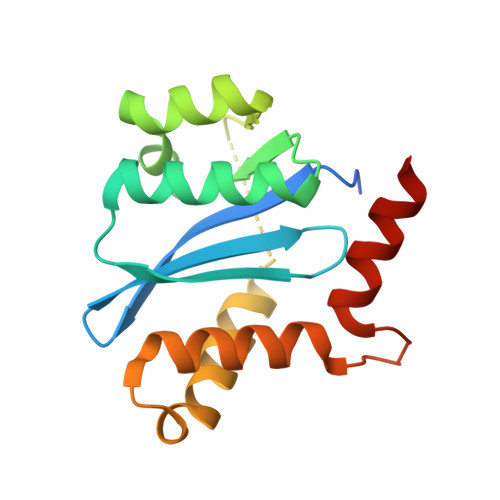A Conformational Escape Reaction of HIV-1 against an Allosteric Integrase Inhibitor.
Nakamura, T., Nakamura, T., Amano, M., Miyakawa, T., Yamagata, Y., Matsuoka, M., Nakata, H.(2020) J Virol 94
- PubMed: 32611758
- DOI: https://doi.org/10.1128/JVI.00486-20
- Primary Citation of Related Structures:
6L0C - PubMed Abstract:
HIV-1 often acquires drug-resistant mutations in spite of the benefits of antiretroviral therapy (ART). HIV-1 integrase (IN) is essential for the concerted integration of HIV-1 DNA into the host genome. IN further contributes to HIV-1 RNA binding, which is required for HIV-1 maturation. Non-catalytic-site integrase inhibitors (NCINIs) have been developed as allosteric IN inhibitors, which perform anti-HIV-1 activity by a multimodal mode of action such as inhibition of the IN-lens epithelium-derived growth factor (LEDGF)/p75 interaction in the early stage and disruption of functional IN multimerization in the late stage of HIV-1 replication. Here, we show that IN undergoes an adaptable conformational change to escape from NCINIs. We observed that NCINI-resistant HIV-1 variants have accumulated 4 amino acid mutations by passage 26 (P26) in the IN-encoding region. We employed high-performance liquid chromatography (HPLC), thermal stability assays, and X-ray crystallographic analysis to show that some amino acid mutations affect the stability and/or dimerization interface of the IN catalytic core domains (CCDs), potentially resulting in the severely decreased multimerization of full-length IN proteins (IN undermultimerization). This undermultimerized IN via NCINI-related mutations was stabilized by HIV-1 RNA and restored to the same level as that of wild-type HIV-1 in viral particles. Recombinant HIV-1 clones with IN undermultimerization propagated similarly to wild-type HIV-1. Our study revealed that HIV-1 can eventually counteract NCINI-induced IN overmultimerization by IN undermultimerization as one of the escape mechanisms. Our findings provide information on the understanding of IN multimerization with or without HIV-1 RNA and may influence the development of anti-HIV-1 strategies. IMPORTANCE Understanding the mechanism of HIV-1 resistance to anti-HIV-1 drugs could lead to the development of novel drugs with increased efficiency, resulting in more effective ART. ART composed of more potent and long-acting anti-HIV-1 drugs can greatly improve drug adherence and also provide HIV-1 prevention such as preexposure prophylaxis. NCINIs with a multimodal mode of action exert potent anti-HIV-1 effects through IN overmultimerization during HIV-1 maturation. However, HIV-1 can acquire some mutations that cause IN undermultimerization to alleviate NCINI-induced IN overmultimerization. This undermultimerized IN was efficiently stabilized by HIV-1 RNA and restored to the same level as that of wild-type HIV-1. Our findings revealed that HIV-1 eventually acquires such a conformational escape reaction to overcome the unique NCINI actions. The investigation into drug-resistant mutations associated with HIV-1 protein multimerization may facilitate the elucidation of its molecular mechanism and functional multimerization, allowing us to develop more potent anti-HIV-1 drugs and unique treatment strategies.
- Department of Hematology, Rheumatology, and Infectious Diseases, Graduate School of Medical Sciences, Faculty of Life Sciences, Kumamoto University, Kumamoto, Japan.
Organizational Affiliation:


















